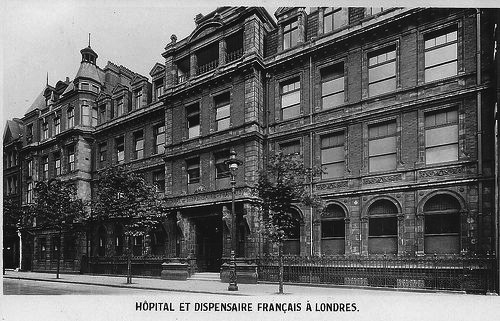Home of the Institute of Urology

The Shaftesbury Hospital started its life in 1867 as the French Hospital', in a building near Leicester Square:
More about the French Hospital
It soon merged with the nearby French Dispensary to form the French Hospital and Dispensary (pictured aove).
In 1899, a larger building was needed, so work began on a site in Shaftesbury Avenue and, in the following year, the purpose-built Hospital opened, with 50 beds initially, increasing to 70 during WW1 when it was used as a "First Treatment" hospital..
In 1932, Geoffrey Parker was appointed as Consultant Surgeon to the French Hospital. Parker had a particular interest in urology and was on the council of the RSM Urology Section as well as being a founder member of BAUS. During the Second World War, Parker joined the Emergency Medical Service (EMS). The French Hospital looked after many war wounded, some from the Blitz, but many were injured French soldiers rescued from the beaches of Dunkirk. Subsequently recruited by SOE (partly due to his French language skills) he was parachuted into occupied France to help the Resistance.
By 1966, the Hospital was in deep financial trouble and was forced to close. The Ministry of Health bought the building in 1967 and the French Hospital became the Shaftesbury Hospital, joining the three P's group - St Peter's, St Paul's and St Philip's - specialising in renal disease.
The hospital was always associated with the Institute of Urology & Nephrology, which came into being in name in 1947, although it was not formally established until 1951 (on two floors at 10 Henrietta Street). In 1970, the teaching facility of the Institute moved to the Shaftesbury Hospital, and the laboratory facility to St Paul's. The Shaftesbury Hospital had 40 beds, and housed all the paediatric urology beds for the St Peter's group.
More about the Institute of Urology & Nephrology
With the closure of the "Three Ps" in 1992, the Institute of Urology moved to the Middlesex Hospital and was finally dis-established in 2006. All its services were moved to University College London Hospital where it has now become the Trust's largest surgical speciality group.
← Back to Hospitals and Institutions Room